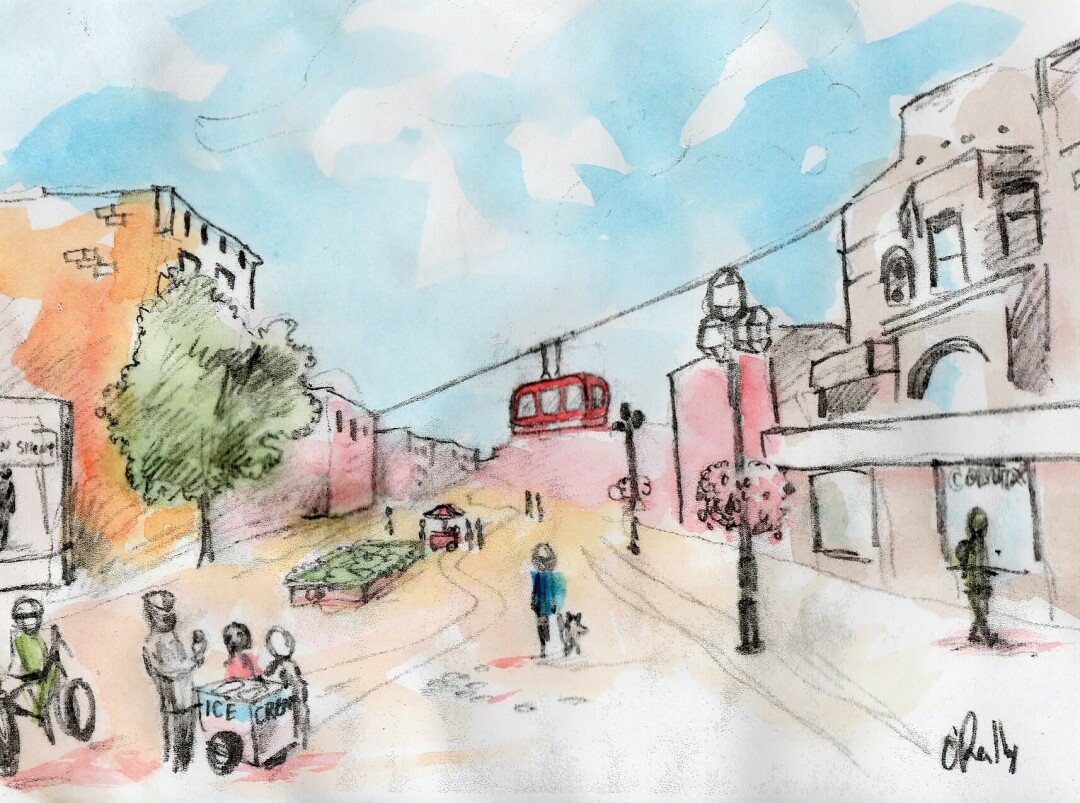Let’s make the Duluth pedestrian mall a reality!
Cartoonist by Kyle O'Reilly

Picture East First Street from the intersection at Lake Avenue to the Essentia Health Campus on Sixth Avenue. Now, imagine how it could look in the future, with a little bit of creative development: A six block stretch of road in the Central Hillside open exclusively for non-motorized use. Cyclists roll gently over cobblestone on a bike lane that winds through raised beds that overflow with lilacs and rutabagas.
There is abundant foot traffic as pedestrians filter in and out of corner markets or loiter around park benches. Near the midpoint of this pedestrian thoroughfare is a block with alley access that accommodates local food trucks who serve everything from wild rice to shaved ice. Open areas are sprinkled with silver maples and rose bushes and serve as impromptu stages for street performers. Magicians, fire dancers and accordion players entertain an audience as it trickles past. At the center of this bustling strip lies the main attraction, a transit center with cables stretched above the treetops to haul commuter cars up and down the hill.
It’s an offbeat idea, but we are finding more and more that the basic functions of downtown districts are changing. Expensive storefronts are less attractive to businesses, as e-commerce displaces brick and mortar shops, while parking fees and congestion dissuade shoppers. Maybe it’s time for us to look for unconventional solutions to our problems. There could be a lot of upsides to building a Pedestrian Mall with free public transit at the foot of Duluth’s Central Hillside.
The most practical part of this idea is to create a safe passage through the city for pedestrians. Weather it’s being used for leisurely strolls, exercise or simply as a means of free transportation, a pedestrian street would create a safe corridor that connects shops and services to the health campus and residential areas.
Since the days of Henry Ford, urban planners have been obsessed with catering to the needs of the automobile. Highways, byways, frontage roads, parking ramps, carpool lanes ... vehicular traffic has become the center of attention in every town in America. That kind of thinking has got to change. The attractiveness of personal transportation is waning due to the costs of ownership and the greater environmental cost to our planet. As Baby Boomers begin to age out of their cars and younger generations opt out of driving for other reasons, our community needs to consider a wider range of transportation options. We need to look back at the way we got around in the pre-war era. It’s not that there’s anything wrong with driving a car, it’s just that we don’t need to drive them everywhere all the time.
More pedestrian space means less traffic, noise, pollution and congestion. Not to mention walking is the cheapest, safest, and healthiest way to get around. The addition of greenery and fresh cobblestone is a natural way to ease our ecological footprint while combating urban blight. Planting trees and shrubs would dampen noise and clean the air, adding pleasant odors and natural color to the landscape. It would also reduce the amount of impermeable surfaces that drain into our city’s greatest asset, Lake Superior.
The most ambitious part of this vision to upgrade the city is to install a really cool cable car system to get us up and down the hill! Sure, many among us take pride in our resemblance to mountain goats or pack mules, but a lot of times it’s just impractical to be a pedestrian in this town. Think of the times we jump in the a just because we don’t feel like carrying a sack of groceries half a dozen blocks up a 9/12 pitch. Think of citizens who are elderly or disabled or simply can’t own a car, who are especially burdened by the vertical nature of our town. Think of winter!
The cable car would not only be a fun way to see the sights, but a practical, weather resistant way to get around. You could take a lazy stroll down the hill in the morning for a jog on the Lakewalk, then catch a gondola ride back up the hill. Or you could enjoy a show at one of the downtown bars without circling the block trying to score a parking space. You could even dust off your bike and ride ten miles across town on flat ground, then hook your beach cruiser on the bike rack of car #2 and float back up to your house on 12th Street.
The real beauty of the cable car system is that the route doesn’t need to follow the grid pattern of the streets, nor does it interfere with existing traffic. It could start at the bottom on 3rd Ave and cut diagonally to Chester Bowl, servicing more of the neighborhood by spanning east and west as it climbs the hill.
Admittedly, there are downsides to this vision of a greener and more accessible Central Hillside, but to the naysayers I would like to point out that our city is in the midst of a great cultural and technological shift, that there are forces at play beyond our understanding, let alone our control. We need to take the reins and choose our own course through the unfolding future. Let’s build the city that we want to live in, a city that integrates our natural landscape and nurtures our independent spirit with a pedestrian mall. A city with bad-ass cable cars!
